The Acer Aspire S7-393 Review: Broadwell Comes To Acer's Ultrabook
by Brett Howse on October 5, 2015 8:00 AM ESTDesign
Looking at the overall design for the Acer S7 reveals that not a lot has changed since 2013. The overall look and feel is almost identical to the original S7. That’s not necessarily a bad thing either, since the original S7 was always a great looking laptop. Acer has kept the Gorilla Glass on the top of the lid, with a white finish behind it which makes for a great look.
The laptop is also very thin and light at just 12.9 mm thick, or 0.51 inches. It weighs in at 1.33 kg or 2.93 lbs. This makes it just 0.6 mm thicker and 0.3 lbs heavier than the ASUS UX305, which is a Core M powered notebook. Considering the Acer has full dual-core mobile Core i7, this is a pretty impressive feat especially since it has basically been carried over since 2013.
The sides of the laptop have a nice sweep to them that looks great. Here we can find the two USB 3.0 ports and the SD card reader, along with the power input and power button. Other than adding another USB port which would be nice, it would be great to see Acer move to a more robust power input. The tiny barrel connector feels like it won’t last over the long haul. The power button could also be moved, since I found myself accidentally turning the notebook off when going to unplug it, since the power button is right at the power jack. There is plenty of space on the keyboard deck to add a power button.
Opening up the laptop shows off its aluminum deck, with silver keys. The deck feels great as most aluminum devices do, and Acer has a nice design element of the edges of the deck wrap upwards which is a nice effect. Luckily this does not carry through to the front of the notebook which is chamfered down so the edges don’t dig into your wrists when you type. This can be an issue on some aluminum notebooks. Acer has done a decent job here but there is still a bit of an edge which is uncomfortable.
The keys and layout are also carried over pretty much exactly from the 2013 model. I have the exact same complaints as Jarred did on the original version: key travel is very shallow, and key feel is not great. For some people they will not be concerned with this, but mushy keys are something I don’t enjoy. Acer has also kept the same compressed key layout, and is missing the top row of function keys. Not only does this mean your standard F keys are not as easily accessed, typical interactions such as changing the volume or display brightness have been moved into the normal keys. It also means the Delete key is down by the space bar, and Escape has been pushed down to the number row, displacing the ~ key which not fits in a half width key with caps lock. While it is very possible that someone will come up with a keyboard layout which is better than the standard layout, I have yet to find it. Acer has lots of room to fit a fifth row of keys on the S7 so I wish that they would.
Another issue with the keys is that they are silver keys on a silver base. With the backlighting off, the keys characters are black and easy to read, but if you have the backlighting on and it’s not a dark room, the light green backlight can cause some loss of contrast with the keys. This is an issue that pretty much all silver keyed notebooks have and it is one of the main reasons I prefer darker key colors.
The trackpad at least has been very good to use, and it offers full customizability through the Synaptics software. Gliding your finger over it is effortless and I’ve found the trackpad to be accurate and have not had any issues with taps or gestures not being recognized. It’s still too bad that in 2015 this is not always the case.
One thing that I really like about Acer’s design is the hinge. The Acer Aspire R 13 also had the same dual torque hinge, and it is something that all notebooks should work towards. The effort to open the notebook is much easier at the start, and once the display opens to about 90° it tightens up. This makes it a lot nicer to use with touch since you get less of a chance of the screen moving on you. While this one is not quite able to be opened with one finger like the R 13, this is likely more due to the light weight of the S7. Sometimes it is the little things, and Acer has done a nice job on their hinges.
The bottom of the S7 is white plastic. I have no issues with this, and it can actually help when using the device in your lap since the plastic won’t get as hot as an aluminum base can.
Overall, Acer’s S7 design is still holding up after a couple of years. It is one of the thinnest Ultrabooks around that still offer full Core i7, and the glass top makes for an elegant look. If Acer could address the keyboard in a future model, it would go a long way to making this S7 feel like the premium device it should be.



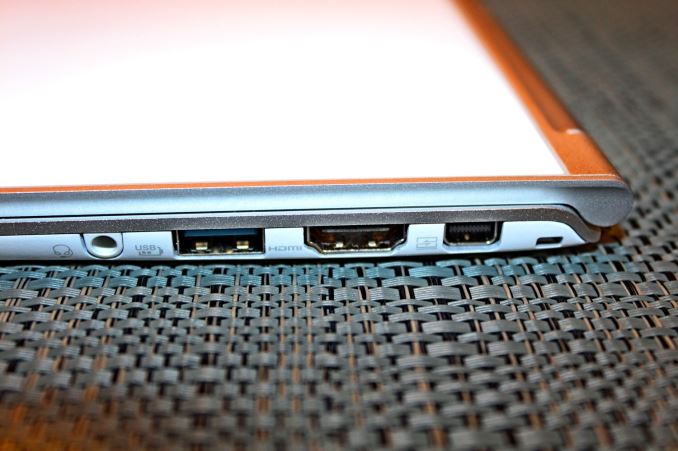
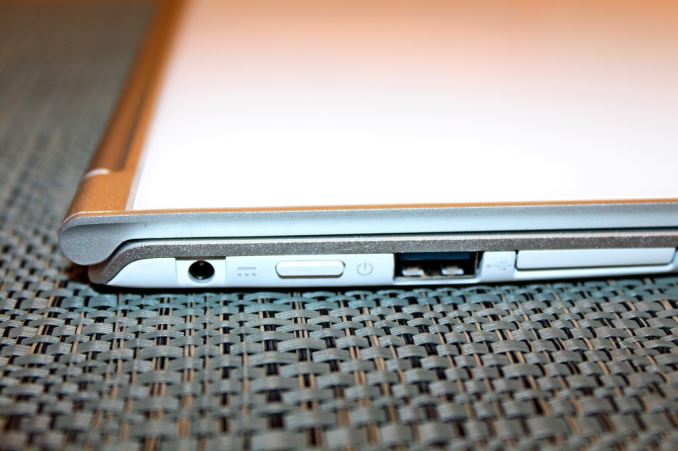
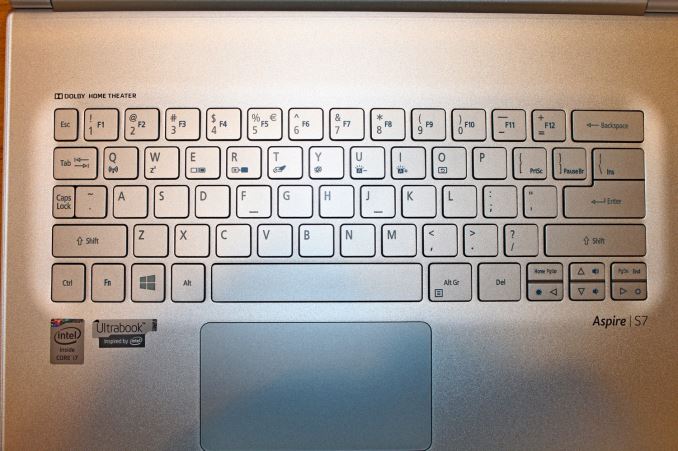
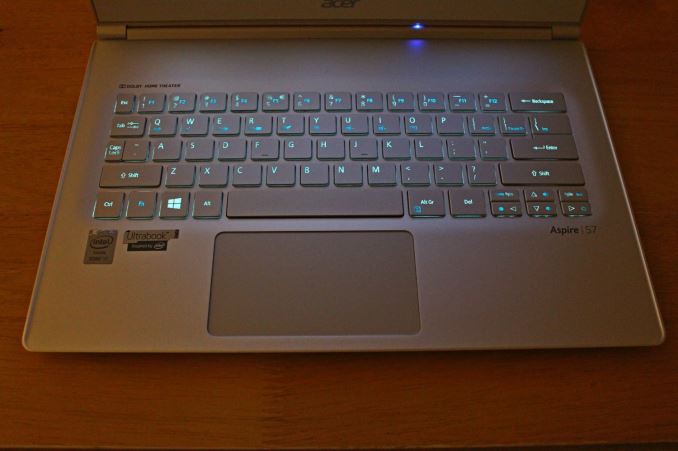
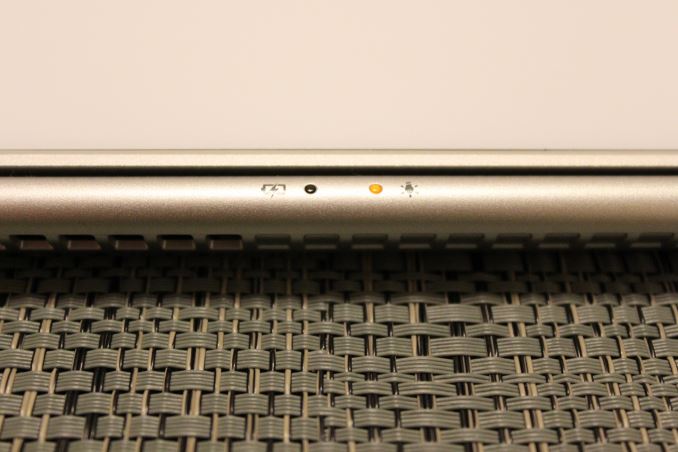








63 Comments
View All Comments
Ethos Evoss - Tuesday, December 15, 2015 - link
why doesn't make sense what a stupid pathetic epic fail pist you had..what is so all sudden bad on raid?
but if crapple woud have it you will go..
woow best thing what apple did.. am i right.. funny boy?
Shadowmaster625 - Monday, October 5, 2015 - link
wow what a rip off. I look forward to seeing this one in the bargain bin for $800 in a few months. No way is it worth $1400.Bob Todd - Monday, October 5, 2015 - link
Indeed. Serious question. Why on earth would I pay $1389 for this vs. $1169 for an HP Spectre x360? It has the same CPU, 8GB of RAM, and a 256GB mSATA SSD. It also has a bigger battery 56Wh. The i5 Spectre with the same RAM/SSD at $999 makes the pricing on this seem even more absurd. It's not like the Acer brand can command a premium. Spectre X360 or XPS 13 over this all day long.nathanddrews - Tuesday, October 6, 2015 - link
*ahem*Gorilla Glass top coating!!!!!1!
kspirit - Monday, October 5, 2015 - link
nnn this is so PRETTY. I think this is the most beautiful ultrabook on the market. Like the model that rules the runway. Ativ Book 9 comes close but this thing is flawless.Oyster - Monday, October 5, 2015 - link
Good review, Brett. I especially liked your detailed coverage of the keyboard. Please continue to review keyboards in depth! I feel that as ultrabooks get thinner and smaller, one of the first things being compromised is the keyboard layout. As a power user (Eclipse, Excel, VS, etc.), I cannot fathom the exclusion of dedicated function, Home, End, Insert, and Delete keys. This is why I love ThinkPad keyboards... if only a Surface- or Dell XPS-like device could have dedicated buttons...Manch - Monday, October 5, 2015 - link
New WIN 10 devices announcing tomorrow. Maybe the rumored larger Surface Pro will have a better keyboard. The type cover is decent but I'm hoping they improve on it and yeah add dedicated keys like you suggest.mkozakewich - Monday, October 5, 2015 - link
They've already got all those dedicated keys. Microsoft threw me for a loop with their key layout, but I've realized it's better than the other ways. I can easily hit the Fn key with my right hand while also using the arrow keys for Home, End, etc.About the only thing I'd change is to add a right-control key. And move the arrows down a bit so you could make them all the same height without making them too short.
Oyster - Monday, October 5, 2015 - link
I realize your needs are unique compared to mine, but I would hardly call the Surface keyboard a power-user tool. As a programmer, I want dedicated function keys first and multimedia keys second... not a huge deal since I can engage the function lock. However, I would hardly call reaching out for the function key for Home and End user-friendly (for programmers at least). Beyond that, it does no good when you actually have function keys as the secondary input for these keys. Case in point, try power-debugging and using the immediate window in VS on a surface keyboard in your lap :).cgalyon - Monday, October 5, 2015 - link
The keyboard on the original S7 was terrible. I don't believe I could type more than one short word before it would either miss a letter or double-enter a letter. It required twice as much work to type on as any other keyboard I've used, which made it essentially unusable for what I needed (report writing).Other than that, it has been an excellent device. The screen is great, it has remained quick and responsive, and is easy to carry around. The hinge has lost none of its rigidity either. If they could only fix the keyboard, it would be perfect.